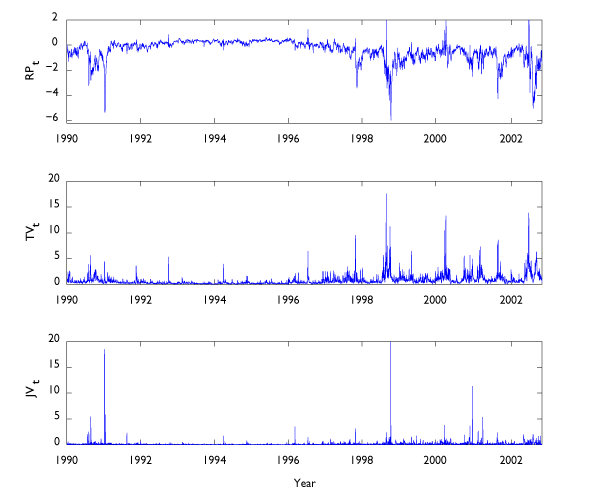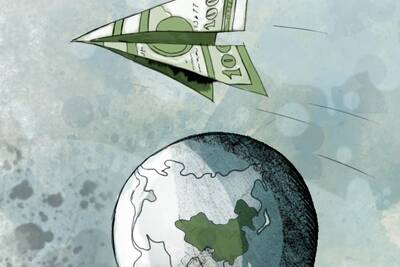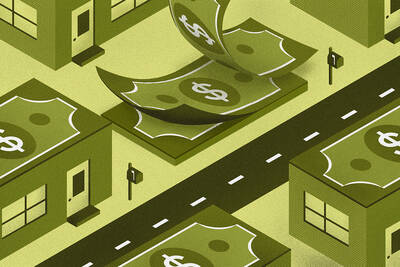Finance & Accounting Jul 5, 2011
Jumps in the Market Make for Jumpy Investors
Short-lived market events can have long-term effects on the appetite for risk
Everyone who invests in the stock market wants to know whether share prices are going to go up or down, since that determines whether they make or lose money. Apart from the price risk, there is another risk that investors face when investing in the stock market, which is known as variance risk. The variance risk is associated with the changing riskiness of the investment environment. For example, the calm period of 2004–2007 was associated with low variance risk, unlike the recent crisis of 2008, which was characterized by large price swings and hence high variance risk. Viktor Todorov, an assistant professor of finance at the Kellogg School of Management, has determined that when there is a jump in the market (a crash or other major event), its effect on prices dissipates much faster than its effect on the “variance risk premium”—how much investors want to be compensated for bearing variance risk.
Some investors look for ways to protect themselves from the risk associated with shorter-term volatility, while others want to get exposure, or speculate on it, Todorov notes. This has resulted in the creation of many derivative contracts that trade directly in volatility, the most prominent being “variance swap contracts.” Todorov explains that investors who buy these contracts “are essentially trading future realized volatility.” He elaborates, “It’s like a typical forward contract—say today we agree about the price of wheat in the future. In the same way, we can agree about the future level of volatility. The two parties to such a contract will exchange money based on their predictions of whether volatility will go above or below that predetermined level.”
While variance swaps are over-the-counter contracts traded by investment banks, their prices can be inferred from a basket of standard exchange-traded options. The resulting synthetic variance swap rate for the S&P 500 stock market index coincides with the volatility index, or VIX, quoted by the Chicago Board of Options Exchange since 1993. The VIX thus provides a direct measure to quantify the importance of variance risk for investors and is often referred to as the “investor’s fears gauge.”
Different Risks
There are two types of variance risk. One is long-term: for example, an investor may enter the market in a period of high risk, but then over time the risk declines to historical levels. In the other type, share prices go up or down very quickly. For example, a macroeconomic announcement that affects the economy as a whole can prompt a dramatic rise and fall of prices on the same day. In 2008, prices rose and fell in such a volatile way that some investors experienced losses of up to 10 percent on a daily basis. In general, of course, investors dislike high volatility because it increases the risk that they could incur substantial losses on their portfolios when it is time for them to sell.
Traditionally, the two types of variance risk are lumped together, but they are very different from the perspective of the investor. Long-term variance calls for gradually rebalancing a portfolio as the level of risk goes up and down, which is not possible when the variance is due to an abrupt price change. Todorov’s research recognized these two components of variance risk and modeled them separately.
Todorov sampled the S&P 500 stock index futures contract every five minutes over the period January 2, 1990, to November 29, 2002. He explains that for his purposes, this high-frequency data was superior to looking at data for the entire trading day: “The market can go down at 9:00 AM and then gradually move back to its starting value at the time of the close. If you use high-frequency data, you can zoom in on what happened in the market and identify where there are jumps—those sudden changes.” The high-frequency data also allowed him to match market activity in real time to economic events and other world news.
Investors become more concerned about possible occurrence of future crashes right after they take place.
Using the high-frequency data, Todorov identified the variance risk in the sample and its different components, in particular the jumps. He used these observations and a mathematical model to construct estimates for the investors’ expectations of future variance risk at each point in time. Todorov then estimated the variance risk premium by calculating the difference between these variance forecasts and the levels of the synthetic variance swap rate, i.e., the VIX index. The latter deviates from the true expectation of future variance risk by exactly the amount investors need to be paid for bearing it.
The Short and Long of It
Todorov found that jumps in the market play an important role in explaining the variance risk premium (Figure 1). When a jump caused large within-day changes, prices became more volatile, but that effect was relatively short-lived. On the other hand, the variance risk premium went up and stayed high for a relatively long period of time, only slowly reverting to its long-term average. Todorov concluded that jumps cause investors to lose their appetite for going into risky investments, which drives up option prices.

Figure 1. Jumps in the market are important determinants of the variance risk premium. The top panel shows the variance risk premium. The middle panel shows the level of volatility. The bottom panel shows jumps in the market. Note that spikes in the bottom panel correspond to spikes in the variance risk premium.
“Investors know the historical volatility trend, that is, whether the market was generally moving up or down over the past twenty years,” he says. “But when they are calculating option prices, they deliberately assume a slightly higher level of volatility. In other words, option prices become higher than what they should be if they reflected the actual level of volatility, because investors are unwilling to take on volatility risk without compensation for it.”
Todorov writes that in contrast to earlier studies, “the results reported here explicitly link the changes in risk aversion with extreme market events, or crashes, and suggest that it is the attitude towards these big changes that gets revised immediately after such events occur.” In other words, investors become more concerned about possible occurrence of future crashes right after they take place. This impact is most clearly seen on the options market, as these assets are most sensitive to these fears of investors.
Todorov says that historically, using standard economic models, it has been hard to reconcile large fluctuations in the stock market with the relatively calm and smooth aggregate macroeconomic fundamentals such as consumption. His findings suggest that part of this gap is due to the fact that risk aversion fluctuates in response to jumps in the market.
Related reading on Kellogg Insight
Dividends Driving Volatility: Erratic stock prices due to concerns over short-term dividend payments
The VIX, CIV, and MFIV: Measuring up the accuracy of option-based predictors of volatility
Todorov, Viktor. 2010. “Variance Risk Premium Dynamics: The Role of Jumps.” Review of Financial Studies. 23(1): 345-383.


